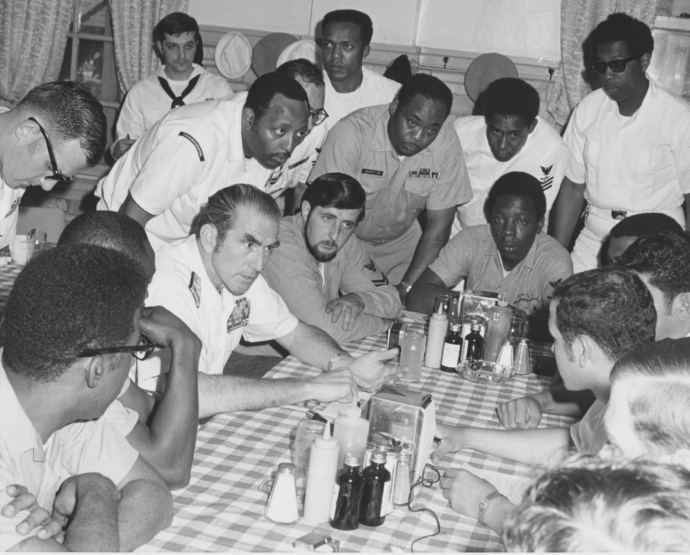By Lt. Sam Straus
Despite enlistment bonuses, recruiter rodeos, a renewed focus on influencers, and modest policy changes from PERS, the U.S. Navy continuously fails to keep Sailors from walking out the door and to convince would-be recruits from stepping in. This problem has gotten so severe that the Navy is on target to miss recruiting goals by over 7,000 personnel for FY23, and gapped billets at-sea continue to exceed 9,000.1, 2* This shortage will continue as overworked enlisted Sailors leave, refusing the possibility of being sent TAD on additional deployments, and officers resign, rejecting uncertain billet assignments.
Reports – both internal and external to the DoD – point fingers at societal health, youth hesitancy, and a declining perspective of the military as causal explanations for this phenomenon. But they fail to realize that current socio-economic conditions have the potential for the greatest boon to military enlistment and retention since the 2008 financial crash and the attacks on 9/11.3, 4 Why then are we failing to meet our numbers?
To many in the fleet, the Navy is a job just like any other. In an economy that promotes career-jumping from ladder to ladder, it is no surprise that Sailors forego internal promotions for a chance to climb, all without the burdens of weekend duty, mid-watches, and extended deployments. The traditional benefits of naval service – adventure, camaraderie, leadership experience, stable pay, and robust benefits – no longer match the costs associated with a sea-going career. While this may not be the case for every Sailor, personnel numbers indicate a strong correlation. So what do we do?
We need to make the Navy a better place to work. Luckily for us, many of the levers to do this are within our control.
To offer a historical lesson, Admiral Zumwalt faced a similar struggle as he assumed the office of CNO amidst a monumental shift from a conscript to all-volunteer force, a force that was wracked by social divisions and readiness issues. His approach then, as ours should be now, was to dismantle the immediate barriers to Sailor happiness and success – increasing Quality of Life, most often by decreasing administrative requirements.5 These changes typically arrived in messages known as “Z-Grams,” personal communiqués from Zumwalt to the fleet.
With this in mind, we should reestablish Retention Study Groups (RSGs) and the associated Z-Grams. To paraphrase Z-Gram #2, RSGs are “…Representative groups of junior officers and enlisted (Sailors) from the major surface, aviation and submarine communities…to surface those current views and recommendations from the fleet which appear to represent consensus.” These groups formed the foundation of CNO Zumwalt’s efforts to boost retention and spawned many of the benefits we enjoy today, including standard Leave and Earning Statements, Ombudsmen, Holiday Routine at sea, as well as equal opportunity for all Sailors regardless of sex, race, or creed.6 The true power of the RSGs and Z-Grams derived from their ability to focus the Navy on what mattered most – its people and their ability to win at sea – by removing deckplate-level friction points from Sailors’ lives. In other words, these efforts rebalanced the cost-benefit analysis to new or continued naval service.

We must make similar efforts now by transforming or sunsetting the programmatic barriers to Sailor success, for example, post-9/11 ATFP watches, redundant OFRP training requirements, and an antiquated 3M program. Revamping these policies will bring the Navy in line with Sailor consensus, shifting complaints from, “Why are we doing the same certification for MOB-S, SAR, and MOB-N?” to “Why aren’t we making GQ drills even more challenging?” The latter is what we need to promote crew morale and warfighting readiness, and to attract and retain the best.
Will implementing this approach be met with pushback from status quo leaders throughout the fleet? Of course, but that simply reinforces the necessity for unrelenting advocacy and professional engagement. We cannot let entrenched interests or pride stop us from getting better. Our “standard” Navy approach of sending decisions through committee for neutering and pacification cannot make the serious changes needed to affect the minds of Sailors that are considering leaving the service. Only direct action and real authority from the CNO’s office have the force to dismantle many of the obstacles to productivity, performance, and morale.7 “Getting Real” with these issues requires outspoken action, a renewed focus on what our Sailors need, and a keen ear for what they want.
It will take thought and care to get this right, but the Navy’s history offers a valuable example on how to achieve success. It is time to restart RSGs and end the retention crisis. Time for the F-Gram!
Lt. Sam Straus is a Surface Warfare Officer in the U.S. Navy. His views are his own and do not reflect the official position or policy of the U.S. Government, the U.S. Department of Defense, or the U.S. Navy.
*Correction, the number of gapped at-sea billets is 9,000, not 750 as originally stated.
References
1. Correll, D. S. (2023, September 14). Navy will miss recruiting goals by 7,000 sailors this year. Retrieved from Navy Times: https://www.navytimes.com/news/your-navy/2023/09/14/navy-will-miss-recruiting-goals-by-7000-sailors-this-year/
2. Mongilio, H. (2023, February 1). Navy Exceeding FY 2023 Sailor Retention Goals, Says Q1 Data. Retrieved from USNI News: https://news.usni.org/2023/02/01/navy-exceeding-fy-2023-sailor-retention-goals-says-q1-data
and
Heather Mongilio, “Navy Needs to Fill About 9,000 At-Sea Billets in More than a Dozen Ratings, Says Personnel Command,” USNI News, October 25, 2022.
3. Magnuson, S. (2023, January 18). Annual Poll Shows Low Confidence in Military. Retrieved from National Defense Magazine: https://www.nationaldefensemagazine.org/articles/2023/1/18/annual-poll-shows-low-confidence-in-military
4. Garamone, J. (2023, April 20). Vice Chiefs Talks Recruiting Shortfalls, Readiness Issues. Retrieved from U.S. Department of Defense: https://www.defense.gov/News/News-Stories/Article/Article/3369472/vice-chiefs-talk-recruiting-shortfalls-readiness-issues/
5. Zumwalt, E. R. (2017, August 11). List of Z-grams. Retrieved from Naval History and Heritage Command: https://www.history.navy.mil/research/library/online-reading-room/title-list-alphabetically/z/list-z-grams.html
6. Ibid.
7. Aghion, P., & Tirole, J. (1997). Formal and Real Authority in Organizations. Journal of Political Economy. Retrieved from https://www.journals.uchicago.edu/doi/10.1086/262063
Featured Image: PHILIPPINE SEA (May 1, 2020) Sailors aboard the Arleigh Burke-class guided-missile destroyer USS Mustin (DDG 89) tie line to a span wire during a replenishment as sea with the dry cargo and ammunition Ship USNS Alan Shepard (T-AKE 3). (U.S. Navy photo by Mass Communication Specialist 3rd Class Cody Beam)


I applaud LT Straus for his thoughtful and well articulated recommendation. I hope and pray that leadership is listening. There are times when it is dangerous to ignore symptoms of serious problems.
What happened to the truly active command retention teams? CINCPACFLT and Navy Recruiting Command were constantly soliciting ideas from the waterfront on retention/Sailor/Family/QOL issues/challenges.
What is described in here needs done. Beyond those items, the biggest thing we could probably do is get more sailors out to sea, making port calls abroad. Less time on unending yard maintenance periods. For those in the yard, better basic living conditions. More, smaller ships that create chances for advancement and learning. Not lightly manned such that the ship doesn’t function. Whatever we send out needs fully manned. Learn to say no to command demands devoid of strategy.